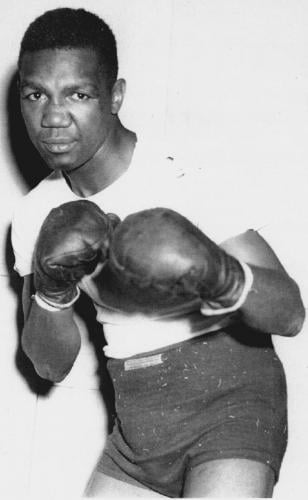Ring Magazine listed Chalky Wright as one of the top 100 greatest punchers of all time. Wright's career included 158 wins (77 by knock out) and 43 losses. He also fought to 17 draws.
Mae West, the actress, helped Chalky Wright achieve his potential. For awhile, he served as West's chauffeur, but she encouraged him to return to the boxing ring.
By 1941, Chalky had achieved his dream:
In the early 1940s, West was one of Hollywood's wealthiest women. Her wise land investments earned tremendous returns. Years of backing Chalky Wright paid off when he became the world featherweight champion in 1941. (West compelled Morrie Cohen to override the racism against black boxers and arrange the match). (Mae West: An Icon in Black and White, by Jill Watts, page 242.)
Although the fictional Chalky White was known as the mayor of Atlantic City's Chicken Bone Beach, that description did not apply to the real Chalky.
Like other boxers, in the waning days of their careers, his championship status did little to help him financially. Listed in "Jet" magazine's November 8, 1951 edition as a "has-been of boxing," Wright was included with "some of the most illustrious name-fighters of all time" who had money troubles:
Chalky Wright, former featherweight champion, who now lives as a fighter's second in Los Angeles. A Maryland attorney recently pleaded for Wright for a $1,000 purse help up several years ago by the boxing commission of that state. He claimed Wright was "destitute." ("Jet," November 8, 1951, at pages 52-53.)
Even Muhammad Ali paid tribute to Chalky as one of the world's best fighters:
Angelo kept telling me, "You're not like any of them old fighters." I know better. Who I am is just what those who came before me made it possible for me to be. Just ahead of me were some of the best fighters the world ever saw, like Joe Louis, Sugar Ray Robinson, Henry Armstrong, Archie Moore, Johnny Bratton, Kid Gavilan, Sandy Saddler, Jersey Joe Walcott, Ezzard Charles, Floyd Patterson, Chalky Wright ... and others who had new styles and powerful punches. (Elliott J. Gorn, quoting Ali, in Muhammad Ali, the People's Champ, atpage 79.)
Later in his life, using the pen name Jay Thomas Caldwell, Chalky wrote a book about himself entitled Me an' You. He died in Los Angeles, in 1957, after slipping in a bathtub.
The International Boxing Hall of Fame provides more background on Chalky Wright:
Albert (Chalky) Wright's career is a lesson in perseverance. Although he battled the best fighters in the world for more than a decade, it wasn't until his 139th pro fight that he earned a title shot.
When that opportunity presented itself - Wright took full advantage.
Born on February 10, 1912 in Durango, Mexico, Wright turned pro two weeks after his 16th birthday and scored a four-round win over Nilo Balles. He spent the early part of his career campaigning in Southern California and learned his craft as he progressed.
Wright never shied from quality competition and fought bantamweight contenders Newsboy Brown and Pablo Dano, ex-champ Baby Arizmendi, featherweight contender Al Reid and three-division champ Henry Armstrong en route to the crown.
It wasn't until he began fighting on the East Coast in 1938 that the boxing world took notice of Wright, who at 5-7 1/2 was unusually tall for a featherweight. He utilized his long reach and packed considerable power for a 126-pounder. By 1941, Wright was ranked among the top featherweights in the world and secured a title fight by decisioning future champion Sal Bartolo.
On September 11, 1941, nearly 14 years after he turned pro, Wright knocked out Joey Archibald in the 11th round to win the world featherweight title. Less than a month after winning the title, Wright engaged in two tough non-title fights, losing to top contender Jose Peralta and decisioning former champ Leo Rodak.
In 1942, Wright knocked out future 126-pound champion Richie Lemos and then made successful title defenses against Harry Jeffra (KO 10) and Lulu Constantino (W 15). But by year's end, Wright lost his crown via decision to Willie Pep, one of boxing's all-time greats. It has been said the first Pep-Wright encounter inaugurated the featherweight division's Golden Era.
Wright challenged Pep for the title in 1944 but lost another decision. He would also drop two non-title contests to the legendary Pep. Among the other champions Wright fought were Phil Terranova (KO 5), Jackie Wilson (W 10, NC 7) and Johnny Bratton (W 10). He finally retired, a veteran of 201 bouts in a career that spanned 20 years, in 1948.
Wright died tragically on August 12, 1957 in Los Angeles after slipping in the bathtub.




No comments:
Post a Comment